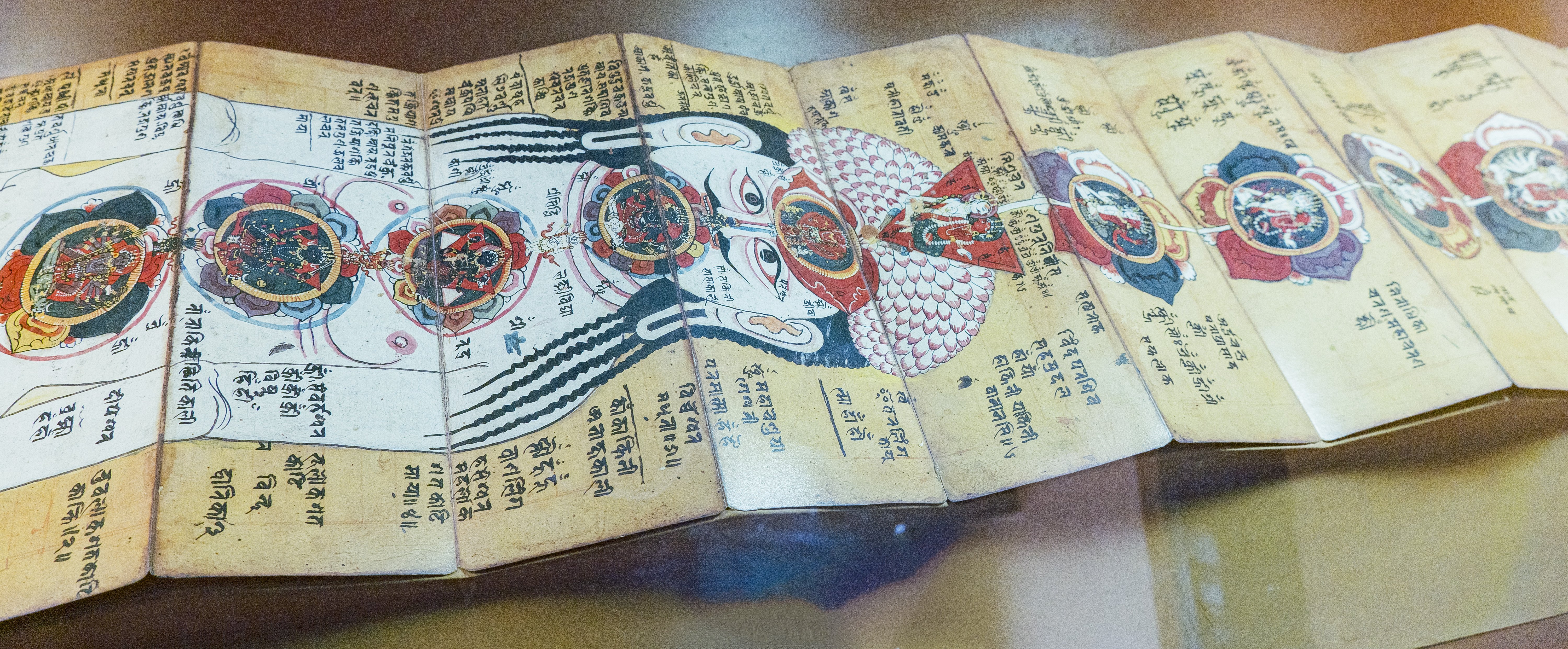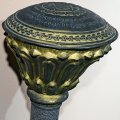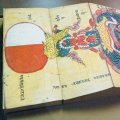Patan Museum (Nepal): photo 152
Photo 152 of 212 in Gallery: Patan Museum (Nepal)

Image title: Illustrated Manuscript of Hindu Tantrism
Description of the photo
This Facsimile shows an Illustrated Manuscript of Hindu Tantrism, from the 17th/18th century origination from Bhaktapur, Nepal.—Materials used: Handmade paper, ink, watercolors.
Description: The folios on display of this manuscript provide an annotated diagram of the esoteric “subtle body” which Hindu tantrism conceives to lie within the “real” human body. This body contains specific energy centers, lotuses or chakras (wheels, circles), usually seven and arranged vertically as illustrated here. The chakras are connected by energy-transmitting channels (nadis), a primary central one (sushumna) and several subsidiary ones. Two critical nadis traverse the subtle body from the big toes to the nostrils, depicted here as a red (solar) line on the right and a blue (lunar) line on the left, both entwining the chakras in their passage.
Each chakra represents an ascending level of consciousness, beginning with the muladhara chakra at the base of the spine and ending above the head in an inverted, thousand-petaled lotus, the sahasrara chakra. This chakra is the locus of Shiva in his esoteric form of Pure Consciousness (caitanya/chaitanya) which pervades the universe. Each of the lesser chakras is presided over by a specific pair of deities, is associated with different sounds, colors, directions and qualities, and encircled with a differing number of lotus petals. Lying dormant at the lowermost chakra is Kundalini Shakti, “coiled-up female energy,” often represented as a serpent but absent in this diagram. By arousing and elevating her through the chakras to unite with Shiva, the Tantric adept transcends his or her own ego and merges with the cosmic consciousness. The union is depicted here as a red goddess and white god seated in a symbolic red triangle among the lotus petals. The achievement of this union requires the mastery of Kundalini Yoga through long apprenticeship under the guidance of a skilled teacher (guru) and involves meditation, breath control, yogic postures, muscle contractions, recitation of mantras and mystic syllables, and sometimes perhaps study of an esoteric manual such as this manuscript.
In this Nepalese pictorialization of the subtle body, the ascent of consciousness does not stop at the seventh chakra, the thousand-petalled lotus above the head, but continues in several additional supra-mental
planes. They terminate in Shiva alone from whom emanates a mystic syllable. Some see in these various levels within and outside the subtle body a correspondence with the various levels of a chaitya’s finial, successive stages of perfection the individual must master to achieve Buddha-hood and release in nirvana.
The subtle body pictured in this manuscript stands on (or emerges from) the primeval ocean symbolizing the depths of the unconscious, defined in the commentary as billions of underworlds. The water and all it contains is supported by Adhara Shakti seated on a frog. In the water Kundalini appears as a spotted serpent among three of Vishnu’s early descent forms, a turtle, fish, and boar, whom she passes on her way to lodge in the lowermost chakra of the subtle body. For most of humanity she will lie there, dormant and unknown. Only the skilled adept will arouse and control her.
The opposite sides of the exhibited folios contain twenty-two individual illustrations among which are a goose, frog and turtle, Vishnu Lying on the Cosmic Ocean, Ganesha, other gods and goddesses, and abstract symbols. Each illustration is accompanied by a short descriptive text which together comprise an abbreviated illustrated glossary of Kundalini Yoga. This side also contains 54 folios of text concerning the worship of the Tantric goddess Kubjika, Bhairava, and one’s guru. Among the more than a hundred, two-sided folios that comprise this large manuscript approximately half are blank.
The leaves of the manuscript are accordion-folded in a format known as thyasaphu. The text is composed in poor Sanskrit and written in Newari script. No date is inscribed. Traditionally, as an esoteric cult object, this manual would only be seen by properly initiated persons. But as with much that was previously secret, in the modern world the manuscript has come into the public domain.
Gallery information:
The Patan Museum is located on the Durbar square of Patan (Lalitpur/Lalitapura, Kathmandu, Nepal) which is associated Keshav Narayan Chowk (Keshavnarayan)—a form of Lord Vishnu. Being listed as a World Heritage Site, the whole of Durbar square is filled with exquisite temples, sculptures and other ancient structures, of which the ancient history history can be traced to the Malla Kings of Lalitpur. It is an important site for both Buddhism and Hinduism.
Photo details:
Date: 2019-12-02
Camera: SONY ILCE-6400
Exposure: 1/50
Aperture: f/5
ISO: 200
Focal length: 18mm
High resolution:
Download file
Size: 8.85 MB
Resolution: 6000 x 2484
© Photograph by Gabe Hiemstra.
License: CC BY-NC-ND 4.0

